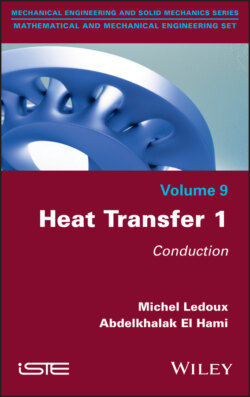Heat Transfer 1

Реклама. ООО «ЛитРес», ИНН: 7719571260.
Оглавление
Abdelkhalak El Hami. Heat Transfer 1
Contents
List of Illustrations
Guide
Pages
Heat Transfer 1. Conduction
Preface
Introduction. I.1. Preamble
I.2. Introduction
I.3. Interlude
1. The Problem of Thermal Conduction: General Comments. 1.1. The fundamental problem of thermal conduction
1.2. Definitions. 1.2.1. Temperature, isothermal surface and gradient
1.2.2. Flow and density of flow
1.3. Relation to thermodynamics
1.3.1. Calorimetry
1.3.2. The first principle
1.3.3. The second principle
2. The Physics of Conduction. 2.1. Introduction
2.2. Fourier’s law. 2.2.1. Experiment
2.2.2. Temperature profile
2.2.3. General expression of the Fourier law
2.3. Heat equation. 2.3.1. General problem
2.3.2. Mono-dimensional plane problem. 2.3.2.1. The terms of conduction per m2 of wall
2.3.2.2. Balance of conduction terms
2.3.2.3. Variation of the temperature with time
2.3.3. Case of the axisymmetric system
2.3.4. Case of the spherical system
2.4. Resolution of a problem
2.5. Examples of application
2.5.1. Problems involving spherical symmetry
3. Conduction in a Stationary Regime. 3.1. Thermal resistance
3.1.1. Thermal resistance: plane geometry
3.1.1.1. Resistance per unit of surface area (per m2)
3.1.1.2. Overall resistance
3.1.1.3. Practical application of thermal resistance
3.1.1.4. Electrical analogy
3.1.2. Thermal resistance: axisymmetric geometry. The case of a cylindrical wall
3.1.3. Thermal resistance to convection
3.1.3.1. Resistance to convection in plane geometry
3.1.3.2. Resistance to convection in axisymmetric geometry
3.1.4. Critical radius
3.2. Examples of the application of thermal resistance in plane geometry
3.3. Examples of the application of the thermal resistance in cylindrical geometry
3.4. Problem of the critical diameter
3.5. Problem with the heat balance
4. Quasi-stationary Model
4.1. We can perform a simplified calculation, adopting the following hypotheses
4.2. Method: instantaneous thermal balance
4.3. Resolution
4.4. Applications for plane systems
4.5. Applications for axisymmetric systems
5. Non-stationary Conduction
5.1. Single-dimensional problem
5.1.1. Temperature imposed at the interface at instant t = 0
5.2. Non-stationary conduction with constant flow density
5.3. Temperature imposed on the wall: sinusoidal variation
5.4. Problem with two walls stuck together
5.5. Application examples. 5.5.1. Simple applications
5.5.2. Some scenes from daily life
6. Fin Theory: Notions and Examples. 6.1. Notions regarding the theory of fins. 6.1.1. Principle of fins
6.1.2. Elementary fin theory
6.1.3. Parallelepiped fin. 6.1.3.1. Solution
6.1.3.2. Problem of an infinite fin
6.1.3.3. Problem of a fin of finite length
6.2. Examples of application
Appendix 1. Heat Equation of a Three-dimensional System
A1.1. Reminder: writing the Fourier law
A1.2. Heat equation
Appendix 2. Heat Equation: Writing in the Main Coordinate Systems
A2.1. The elementary volume
A2.2. Problem with variable physical properties
A2.3. Problem with constant physical properties. A2.3.1. The problem can often be simplified
A2.3.2. This Laplace operator is written, in each of the coordinate systems
A2.3.3. Hence the expressions for the heat equation in a time-dependent regime
A2.4. Time-independent regime
A2.4.1. In the case of variable physical properties
A2.4.2. In the case of constant physical properties
A2.5. Writing the Fourier law. How can the expression for the gradient be found?
Appendix 3. One-dimensional Heat Equation
A3.1. Case of an axisymmetric system
A3.2. Case of a spherical system
A3.2.1. The flow through a sphere of radius r
Appendix 4. Conduction of the Heat in a Non-stationary Regime: Solutions to Classic Problems. Hypotheses:
Appendix 5. Table of erf (x), erfc(x) and ierfc(x) Functions
Appendix 6. Complementary Information Regarding Fins
A6.1. Rectangular wings. Solutions to classic problems
Case 1: Infinitely long fin
Case 2: Fin of length L. Zero flow at the extremity
Case 3: Wing of length L. Convection coefficient h at the end
Appendix 7. The Laplace Transform
A7.1. Definition
A7.2. Derivatives and integrals
A7.3. We will give two examples. A7.3.1. Transform of the Heaviside step function
A7.3.2. Transform of the erfc function
A7.4. Resolution of a problem of single-dimensional non-stationary transfer
Appendix 8. Reminders Regarding Hyperbolic Functions
References
Index. C, E
F, G, H
I, R, T
WILEY END USER LICENSE AGREEMENT
Отрывок из книги
Mathematical and Mechanical Engineering Set
.....
Let us entrust Ludwig Boltzmann to direct the film. Our B movie heroes are getting agitated, delivering blows to one another. Each one of them has moderate kinetic energy, distributed heterogeneously among them in the room. For some reason, they get involved in a general brawl. Their average kinetic energy becomes much greater.
In everyday language, we would say that things are hotting up.
.....